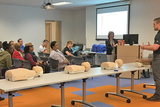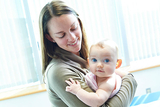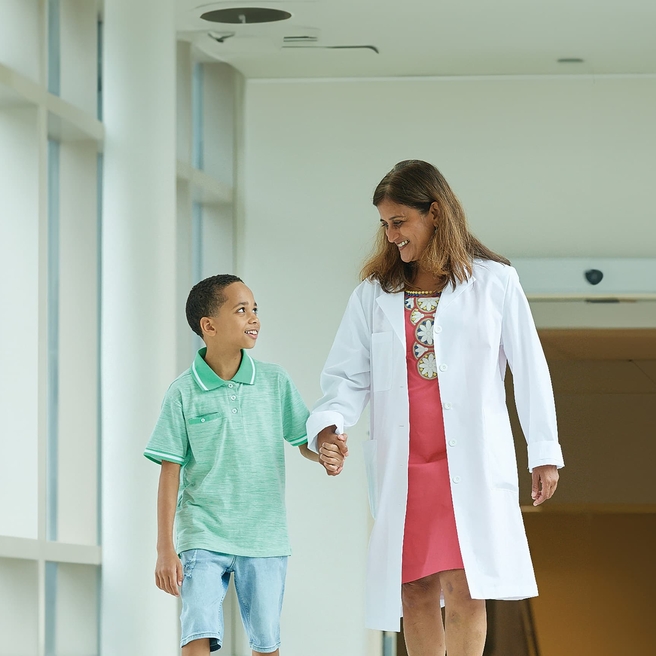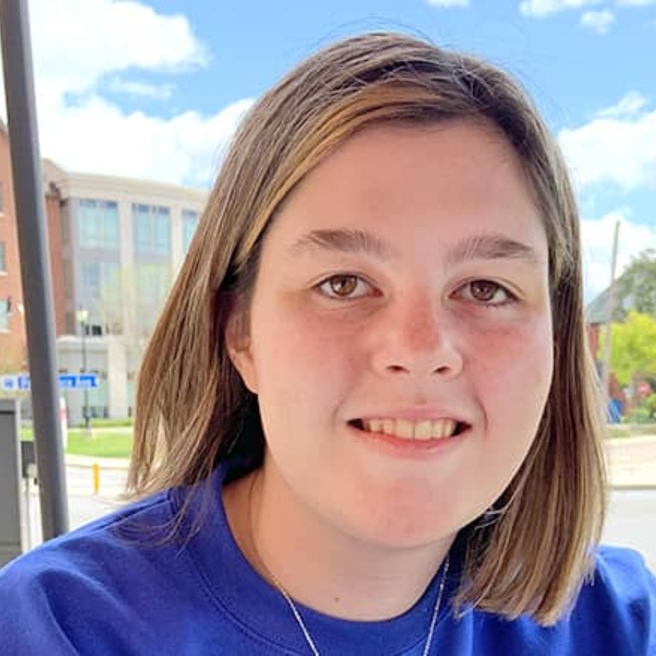What is sudden cardiac arrest?
Sudden cardiac arrest (SCA) occurs when the heart suddenly and unexpectedly stops beating. It is caused by the immediate loss of electrical heart function, usually from an irregular and rapid quivering of the ventricles (called ventricular fibrillation).
Rarely, the abnormal rhythms can resolve on their own. Usually, though, these rhythms degenerate to ventricular fibrillation (cardiac arrest in which the heart is quivering) or asystole (cardiac arrest in which the heart stops beating). Early emergency treatment with cardiopulmonary resuscitation (CPR) or an automated external defibrillator (AED) can help restart a stopped heart and allow return of a normal heartbeat to help prevent sudden cardiac death (SCD).
Although SCA is rare in children, it can affect anyone, even those who are physically fit. Each year, SCA claims the lives of over 2,000 children and adolescents in the U.S. and accounts for approximately 3-5 percent of all deaths in children aged 5-19 years. It is also responsible for 10-15 percent of sudden unexpected infant deaths.
Risk factors for sudden cardiac arrest
Sudden cardiac arrest occurs more frequently in males than females, and, in children, most commonly occurs between 10-19 years of age. Still, it’s important to note that SCA may occur in children of all ages, even infants.
Some other risk factors include:
- Athletic activity: Two-thirds of the deaths caused by SCA in children occur during exercise or activity. SCA is the leading cause of death in young athletes, accounting for 75 percent of all athlete-related deaths.
- Known congenital heart disease or structural heart abnormalities.
- Known abnormal heart rhythms associated with congenital heart disease. Most commonly, these include ventricular arrhythmias or atrial arrhythmias, especially the post-operative state or in the presence of a weakened heart.
- Known abnormal heart rhythms that are very rapid, even with a normal heart. For example, rapid ventricular tachycardia or atrial fibrillation with a rapid ventricular response.
- Undiagnosed cardiac conditions, especially those known to be associated with sudden cardiac arrest.
- Obesity and hypertension.
- Exposure to drugs, medications, toxins and infectious agents, including cocaine, inhalants, recreational or club drugs, and some prescription medications.
- Sudden blow to the chest directly over the heart (commotio cordis).
- Family history of:
- Known heart abnormalities
- Sudden death before 50 years of age
- Conditions known to cause SCA, such as long QT syndrome, Brugada syndrome, catecholaminergic polymorphic ventricular tachycardia (CPVT), hypertrophic cardiomyopathy (HCM), arrhythmogenic right ventricular cardiomyopathy (ARVC) or other familial cardiomyopathies
- Unexplained fainting or seizures
If you have a family history of any of these conditions, immediate family members should be checked out for those conditions known to be inherited or caused by a genetic mutation. This can help you identify a condition early and possibly prevent SCA or SCD.
Causes of sudden cardiac arrest
Sudden cardiac arrest is usually caused by ventricular fibrillation (VF), an abnormality in the heart's electrical system. VF causes the heart to quiver and blood flow to the body and brain to stop. VF is not the same thing as a heart attack. A heart attack results from a blockage in a coronary artery and subsequent damage to the heart muscle. A heart attack can lead to SCA.
SCA may also be associated with a sudden stop of all electrical activity in the heart (also called asystole). It can also be associated with pulseless electrical activity (PEA), a disorganized electrical activity that does not cause the heart to contract and pump blood.
Sudden cardiac death in childhood is typically caused by different heart conditions than those causing the majority of SCD in adults.
The most common causes of SCA in children are:
- Structural cardiac abnormalities (congenital heart diseases and postoperative repairs, coronary artery anomalies, or Marfan syndrome)
- Abnormalities of the electrical system of the heart (also known as primary electrical diseases), such as long QT syndrome and Wolff-Parkinson-White syndrome
- Abnormalities of the heart muscle structure or function, such as hypertrophic cardiomyopathy (HCM), arrhythmogenic right ventricular cardiomyopathy (ARVC), or dilated cardiomyopathies
- Acquired heart disease (inflammation or infection in the heart/myocarditis)
- Arrhythmias, including atrial flutter/atrial fibrillation, ventricular tachycardia (VT), ventricular fibrillation (VF), sinus node dysfunction, and complete heart block
- Atherosclerotic coronary disease
- Commotio cordis (caused by a blow to the chest)
- Drug-induced SCA
Conditions causing SCD are typically not diagnosed prior to the arrest. In many cases, these conditions are inherited, but family members are unaware of their family history.
Symptoms of sudden cardiac arrest
Warning signs and symptoms do exist in 30-50 percent of cases of SCA/SCD, but are often ignored or misunderstood.
If your child has any of the warning signs or symptoms of SCA, make an immediate appointment with your pediatrician or take your child to the ER if they appear distressed in any way.
Warning signs and symptoms may include:
- Exercise related chest pain or discomfort
- Unexplained fainting (syncope) or near fainting, especially with or just after activity
- Repeated episodes of unexplained fainting (syncope)
- History of recurrent fainting or unusual seizures/seizure-like activity, especially with or just after activity
- Dizziness or lightheadedness
- Racing heart rate, palpitations
- Excessive fatigue or unexplained shortness of breath with exercise
- Recent viral infection with chest pain or change in exercise tolerance
- History of a heart murmur whose cause has not been determined with certainty
- History of high blood pressure
- Prior evaluation or treatment for a cardiac condition
- Restriction from activity because of a cardiac issue
In more than half of the cases of SCA in children, death was completely unexpected. Young people are often unaware of the risk factors and don’t tell adults when they experience the symptoms. They may be frightened, embarrassed or simply unaware that what they are feeling indicates a potentially fatal problem.
Educating parents, children and teenagers about the symptoms and risk factors of SCA is one way to help prevent it.
Diagnosis of sudden cardiac arrest
If your general pediatrician suspects your child is at risk for SCA, she might refer you to a pediatric cardiologist, a doctor who specializes in heart problems in children.
A pediatric cardiologist will listen to your child’s heart and ask questions about the circumstances that led to the symptoms, your child’s medical history and the family medical history. The cardiologist will read an electrocardiogram (ECG or EKG), a record of the electrical activity of your child’s heart, to determine whether a heart problem may be causing your child's symptoms.
Your child’s cardiologist might order other tests, such as an exercise stress test, echocardiogram, or chest X-ray. You might be sent home with an ambulatory cardiac event monitor or a Holter monitor to continuously record your child's heart rhythm for a specific length of time as she goes about her normal activities.
If your child has experienced one of the warning signs or symptoms of sudden cardiac arrest, their pediatric cardiology evaluation may indicate a normal heart needing no further testing. It could also result in further testing or follow up evaluations, if needed.
Treatment for sudden cardiac arrest
SCA requires immediate attention. If your child suddenly collapses and does not immediately awaken, call 911 and start CPR. If an AED is available, it should be applied.
The best chance of SCA survival is prompt recognition, and a planned emergency response with CPR and AED use.
If sudden cardiac arrest is not treated within minutes to establish a normal heart rhythm, a person will die. The heart is either quivering or has stopped completely, and cannot pump blood effectively. Blood flow to the brain and body stops and death results if life-sustaining care is not provided.
Chain of survival
The chain of survival concept represents the sequence of five events that must occur quickly to optimize a person's chance of surviving a cardiac arrest. The five links of the chain:
- Immediate recognition of cardiac arrest and activation of the emergency response system.
- Early cardiopulmonary resuscitation (CPR) with emphasis on chest compressions.
- Rapid defibrillation using an AED can establish a normal heart rhythm to a person suffering a cardiac arrest. It is most effective when it is performed in the first few minutes of a cardiac arrest.
- Effective advanced life support.
- Integrated post-cardiac arrest care.
How CPR works
CPR manually pumps blood around the body and maintains the circulation, allowing blood with oxygen to reach the body organs and brain, until a normal heart beat can be restored. Hands-only CPR is most effective when performed right after the collapse and when an AED is also applied quickly.
CPR should continue until emergency medical services (EMS) arrives and takes over, unless the affected person has a return of normal circulation (either spontaneously or after AED shock) and is awake (moving and breathing), and alert and talking. Rescue breathing as part of CPR is recommended to be used by trained health professionals.
How AEDs work
The heart must be “defibrillated” quickly, because a person's chance of surviving drops by 10 percent for each minute a normal heartbeat is not restored.
When the heart is in sudden cardiac arrest, an AED can deliver an electrical shock through the chest (which travels to the heart) to halt the abnormal, ineffective rhythm. This enables a normal heart rhythm to resume.
AEDs are safe for use by anyone who has been trained to use them, as well as bystanders who follow instructions given by the devices. Studies have shown that sixth-graders briefly trained in AED use are able to correctly operate the device almost as quickly as emergency medical personnel.
Broad deployment of AEDs and increased bystander CPR could prevent as many as 50,000 deaths each year in the United States that are caused by SCA. The current national survival from SCA is 8-10 percent. Placing AEDs in schools is a safe and effective way to increase survival rates to 64-74 percent.
Children’s Hospital of Philadelphia’s Youth Heart Watch Program has a School AED Program committed to making AEDs available to all children and adolescents. Watch this short video to see experts demonstrate how to perform CPR and use an AED
Implantable cardioverter defibrillators (ICD)
A pediatric cardiologist, cardiac electrophysiologist (EP) or surgeon may implant a defibrillator in a child or adolescent who has had a SCA or is thought to be at risk for having a SCA to prevent SCD. An implantable cardioverter defibrillator is a small computerized device with an energy source for defibrillation or pacing.
An ICD has wires with electrodes on the ends that connect to your child’s heart chambers. It can recognize a life-threatening abnormal rhythm and provide an electrical shock that allows the normal rhythm to resume.
An ICD is implanted following guidelines for children who have sustained a SCA and survived or who are thought to be at high risk for such a cardiac event. Children who have received an ICD for either reason may have these ICDs discharge to prevent SCD.
Prevention

Youth Heart Watch Program
The Youth Heart Watch program aims to prevent sudden cardiac death among children and adolescents by placing AEDs in schools, recreation centers and other public places.
Primary prevention
Primary prevention refers to methods used to prevent sudden cardiac arrest from occurring. Reducing the incidence and prevalence of sudden cardiac death requires identification of a predisposing condition and early intervention.
Primary prevention includes evaluation of those with warning signs and symptoms or a positive family history. Identifying a heart condition or other risk factors allows for early intervention with medication, lifestyle alterations, and defibrillation devices.
Children’s Hospital of Philadelphia’s Youth Heart Watch program performs primary prevention that conducts screenings in the community to identify young people with potentially serious heart problems. Learn more about the Heart Health Screening Study.
Secondary prevention
Secondary prevention refers to methods used to prevent sudden cardiac death from occurring once someone has experienced a sudden cardiac arrest. These methods include cardiopulmonary resuscitation (CPR), use of an automated external defibrillator (AED), or an implantable cardioverter defibrillator (ICD).
In an effort to prevent sudden cardiac death among children and adolescents, YHW runs a secondary prevention program that is committed to implementing AED programs in schools, recreation centers and other public places. Learn more about the School AED Program.
Long-term outlook for sudden cardiac arrest
When sudden cardiac arrest is identified and treated, children and adolescents can be expected to have an excellent outlook or prognosis. Outcomes will vary depending on the cause of the SCA.

Why Choose Us
Our specialists are leading the way in the diagnosis, treatment, and research of congenital and acquired heart conditions.
Resources to help
Cardiac Center Resources
We know that caring for a child with a heart condition can be stressful. To help you find answers to your questions – either before or after visiting the Cardiac Center – we’ve created this list of educational health resources.


